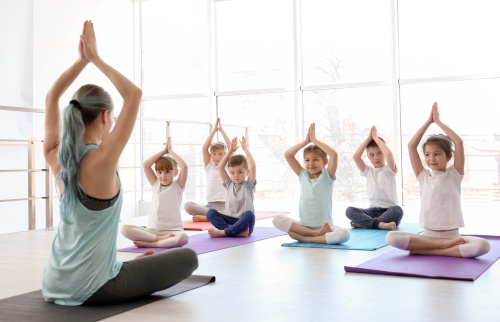After a tumultuous few years teaching during a pandemic, some educators are embarking on a unique approach to social and emotional learning (SEL) training this summer: They’re pursuing a virtual wellness, SEL, and yoga training course.
Graduates of Breathe For Change’s 200-hour program will be certified to teach inclusive yoga classes to both adults and young people and lead SEL and wellness experiences in their schools, districts, and organizations.
“Our whole approach is a community-wide wellness approach–the home-school connection matters deeply,” said Dr. Ilana Nankin, Breathe For Change’s founder and CEO.
The certification program is designed specifically for educators who can use their SEL and yoga education for teacher well-being and student SEL.
Educators were stressed, overwhelmed, and overworked before the pandemic escalated things, said Nankin, a former PreK teacher, who focused on this topic in her dissertation. When Nankin used her research and teaching experiences to create Breathe For Change in 2015, educators who participated in the program saw transformations in their students, from an SEL perspective, but also from an academic perspective.
It reveals “how powerful SEL and wellness practices can be for students’ lives, in school and in an educational context,” she said. “Then, as educators, how do we utilize wellness, SEL, yoga, and mindfulness as vehicles for healing and social change across our whole community?”
Educator graduates have taken their training and started mindfulness programs in their schools, established yoga clubs for kids, are leading family wellness nights, hold SEL and well-being PD for their colleagues, and are transforming school culture and climate.
Breathe For Change’s SEL training component is split into various components, including breath awareness, mindful movement, community connection, and creative expression. Educators integrate these practices into their instruction while also weaving them together to facilitate wellness workshops and professional development.
The program also adds an “F” to turn SEL into SEL*F. That “F” stands for facilitation, and the training equips educators to lead wellness and SEL practices and programs in their schools and districts.
“It’s so critically important to embody, live, and breathe the practices and SEL competencies we hope to teach our kids,” Nankin said. “Training starts with a focus on transformation of self–educators first and foremost should take care of their own well-being and prioritize their own self-care so they can do the essential work of giving themselves to their communities.”
This summer’s educator participants draw attention to two growing issues: teacher burnout and the increased need for SEL and mental health support among students.
A nationally representative survey of teachers by RAND Education and Labor in late January and early February 2021 found that educators were feeling depressed and burned out from their jobs at higher rates than the general population. In the survey, one in four teachers–particularly Black teachers–reported that they were considering leaving their jobs at the end of the school year. Only one in six said the same before the pandemic.
A January 2022 study published in JAMA Pediatrics confirmed what many educators, administrators, and support staff already knew: School closures, disrupted learning, and a pandemic year have coalesced to create an alarming mental health crisis among teenagers.
The study found that up to 60 percent of students are experiencing “strong distress,” including anxiety and depression. The results echoed a recent American Psychological Association (APA) report, which found that more than 80 percent of teenagers experienced “more intense stress” during the pandemic.
- Friday 5: College and career readiness - April 12, 2024
- Cybersecurity: eSN Innovation Roundtable - April 11, 2024
- School-home communication remains a challenge for many districts - April 10, 2024

